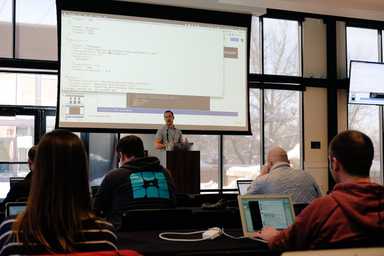I’m attending my third LoopConf and I can’t recommend it enough. It is an independent, developer-focused WordPress conference. I really enjoyed the single track focus and I was able to network nerd out with other advanced developers the entire time.
This year Matt Cheney (@populist) and I did a workshop on Automating WordPress Updates.
The final product took us over a year to achieve and was a series of progressive steps. In this blog post, I want to share with you that journey and how I went from manually updating and checking sites to having it be a fully automated process that is rarely thought about.
This all started with scalewp.io, a WordPress site I am responsible for keeping up to date. I was logging in to WordPress, checking for updates, creating a copy of the production site, applying the updates and then running a quick QA to make sure things haven’t broken. This was a tedious process that took away from more important work I was also responsible for so I looked to automate this update process.
I broke the problem down into two pieces: checking for and applying updates and checking that those updates didn’t break the site. So I started a bash script that I could run locally. Checking for and applying updates was relatively easy using wp-cli.
Next, I explored scripting the visual check. After trying quite a few different tools I landed on BackstopJS, a NodejS app for visually comparing two sites. In my case, the copy of my site with WordPress updates applied compared to the production site.
I also scripted creating the new environment and handling deployments if the tests pass. This script saved me about 30 minutes and it was something I could run every day. I would hop on in the morning, run the script, then go about my day.
I didn’t go straight to full automation and encourage you not to either. Start with what you are doing now. Be honest with yourself - are you fully testing every component of each site or just doing a quick visual spot check? I’ll be the answer is a quick spot check. So script that spot check, run it for a few weeks and find the rough edges.
Now that there is a solid foundation, move it to the cloud and automate the script running. I won’t go into code details here but I wrote about this first implementation running in CircleCI back in October 2016 if you want to read more.
After that, I let it this script run automatically in the cloud for a few months. At one point I noticed the site was performing slowly. It turned out a plugin update had really decreased site speed even though visually things were exactly the same. It was time to iterate and improve the tests by also checking for performance. I settled on Google’s Lighthouse, which audits sites for a variety of things, including performance. So now my script checks performance as well and if performance drops more than a few points updates don’t get deployed.
I kept talking about and sharing this script with others. Eventually, colleagues asked me to run the automated updates on some sites they are responsible for as well. At that point I worked on refactoring the script again, this time adding scalability to update and test multiple sites.
Again, I this ran for a month or so before I came back to the script and added Behat testing to cover items visual regression and performance testing weren’t.
At this point, I am very confident that if all the tests pass updates can be deployed safely. So much so that I don’t double check the results or really even think about the script unless a test fails and I need to debug things, which is very rare.
I want to encourage you to work towards fully automating your updates as well but do so one step at a time. The final result took me well over a year to get right and isn’t something you can do in a night or a weekend. I wrote a little Node app for the LoopConf workshop that can be run locally to perform visual regression tests on a site. Start there by scripting your QA and keep iterating to get to full automation.
